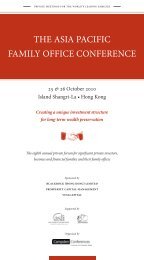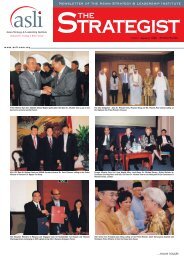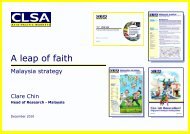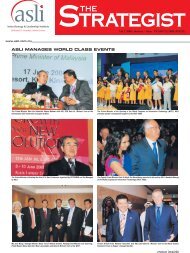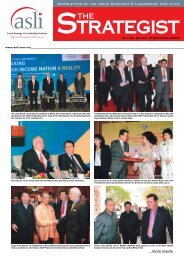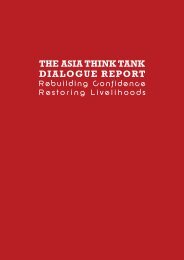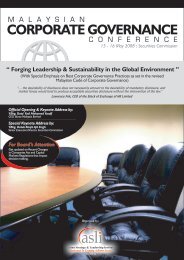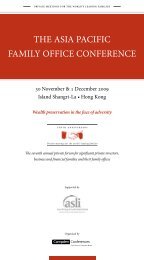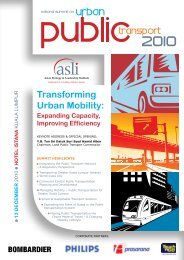What next? by Mr. Aizham Azlan, Manager of CIMB Islamic
What next? by Mr. Aizham Azlan, Manager of CIMB Islamic
What next? by Mr. Aizham Azlan, Manager of CIMB Islamic
- No tags were found...
You also want an ePaper? Increase the reach of your titles
YUMPU automatically turns print PDFs into web optimized ePapers that Google loves.
The Malaysian Debt Market and Derivates – <strong>What</strong> <strong>next</strong>?2
ContentsSection 1Introduction to the Malaysian <strong>Islamic</strong> Capital MarketSection 2Growth <strong>of</strong> <strong>Islamic</strong> Debt Capital MarketsSection 3Malaysia <strong>Islamic</strong> Debt Capital MarketSection 4Conclusion3
Section 1Introduction to the Malaysian <strong>Islamic</strong> Capital Market4
IntroductionThe Malaysian capital market has experienced substantial progress over the past decade,particularly in key areas such as:• growth in fund-raising capacity;• expansion <strong>of</strong> capital market products and services;• adoption <strong>of</strong> many internationally benchmarked practices;• and the development <strong>of</strong> a robust regulatory framework supporting the capital market.The combination <strong>of</strong> these factors, coupled with the country’s strong economic fundamentals,comprehensive supporting infrastructure, presence <strong>of</strong> a pool <strong>of</strong> educated and talentedpr<strong>of</strong>essionals, and cost-competitive operational resources have all combined to create anattractive investment environment for investors.Despite the setbacks in the growth path experienced during the financial crisis <strong>of</strong> 1997–98, thesestrengths are still very present in Malaysia and represent cogent factors in favor <strong>of</strong> the futuredevelopment <strong>of</strong> the capital market.5
Malaysian Experience – <strong>Islamic</strong> Capital Market• Malaysia’s first Shariah compliant savings institution was formed in 1963 serving the MalayMuslims outside the conventional market.• The <strong>Islamic</strong> Banking Act was enacted in 1983 and the Takaful Act in 1984 which immediatelyafter that, the country’s first <strong>Islamic</strong> Bank and Takaful company was established• Ten years later, the <strong>Islamic</strong> Banking Window Scheme or “Skim Perbankan Tanpa Faedah” wasintroduced which allowed all conventional banks to <strong>of</strong>fer <strong>Islamic</strong> financial products andservices. Resulting from this initiative the <strong>Islamic</strong> banking and finance share <strong>of</strong> market grewfrom a mere 1% over the last 10 years to about 6% nearly overnight.• Over the course <strong>of</strong> the last 6 years, <strong>Islamic</strong> banking asset in Malaysia has grown to more than150%.• As at 2009, Malaysia’s <strong>Islamic</strong> financial market is to a degree complete comprising thebanking sector, the inter-bank money market, the debt and equity market, asset management,takaful, other non-banking financial institutions and the derivatives market.6
Malaysian Experience – <strong>Islamic</strong> Capital Market<strong>Islamic</strong> Capital Market rides on the vast potential <strong>of</strong> Sukuk development:• The more recent development in <strong>Islamic</strong> finance is the growing significance <strong>of</strong> the Sukuk marketto become an increasingly important component <strong>of</strong> the <strong>Islamic</strong> financial system.• The development <strong>of</strong> the Sukuk market will provide opportunities for the corporate sector, thegovernment agencies, multinational corporations (MNCs) and multinational developmentinstitutions to raise funds through the issuance <strong>of</strong> Sukuk to meet their financing requirements.• The Sukuk market also serves as an important platform, complementing the conventional bondmarket in enhancing the effectiveness and efficiency for the mobilization and allocation <strong>of</strong> fundswithin the domestic financial system, as well as in the international financial system.7
Section 2Growth <strong>of</strong> <strong>Islamic</strong> Debt Capital Markets8
Malaysia: Sukuk Market• The first Sukuk issue in Malaysia was the Shell MDS Sdn Bhd Bai' Bithaman Ajil (BBA) in 1990 and since then,Sukuk has evolved in depth and sophistication. Investors can now choose between RM and non-RM denominatedSukuk, as well as the types <strong>of</strong> securities, tenures, asset classes, structures, issuers and risk pr<strong>of</strong>iles that suit theirneeds.• Malaysia also kick-started the international Sukuk market which began in 2001 <strong>by</strong> Kumpulan Guthrie Berhad’sissuance <strong>of</strong> USD 150 million First Global sukuk. Subsequently, in 2002 the Government <strong>of</strong> Malaysia issued aUSD600 million issuance– It has been growing in size ever since with more issuance <strong>of</strong> <strong>Islamic</strong> Eurobonds in theinternational Sukuk market.• 17 years later, the Malaysian Sukuk market is the world's largest <strong>Islamic</strong> Sukuk market, representing about twothirds <strong>of</strong> the USD66 billion in outstanding Sukuk globally. In addition, the Securities Commission <strong>of</strong> Malaysia hasapproved a total <strong>of</strong> 42 bond issues amounting to RM52.40 billion <strong>of</strong> which 15 issues were Sukuk, valued at RM32.1billion. The value represented 61.3% <strong>of</strong> total new bond issues approved as <strong>of</strong> 2009. The reduce percentage ascompared to previous years is mainly due to proposed issuance <strong>by</strong> issuers from the conventional financial servicessector.• The announcement on tax neutrality was done in 2004 where the issuances <strong>of</strong> sukuk have increased for the followingyears.• The Ringgit Sukuk grew significantly since 2003, versus conventional bonds, as illustrated below:RM Billion40.0035.0030.0025.0020.0015.0010.005.0010.8<strong>Islamic</strong> BondsConventionalBonds25.514.2Source: Bloomberg’sUnderwriter LeagueTable17.56.1 6.225.611.638.716.021.527.132.220.339.121.40.002003 2004 2005 2006 2007 2008 20098 December 20109
Global: Growth <strong>of</strong> the <strong>Islamic</strong> Debt Capital Markets (Cont’d)• The global Sukuk market has experienced a boom in recent years, spurred <strong>by</strong> the advantages <strong>of</strong>fered <strong>by</strong>Sukuk (as highlighted in the previous slides) over conventional bonds.• Sukuk issues globally have grown exponentially in the last 4 years, from USD 5.7 billion in 2004 to USD30.8 billion in 2007. There was a decline in Sukuk issuance <strong>of</strong> more than 50% in 2008, due to bleakeconomic conditions. As <strong>of</strong> Year 2009, the Sukuk market has started picking up with over USD20 billionnew sukuk issuance entering the market.Global New Sukuk IssuanceUSD million4000030,8033000018,12520,1512000013,0925,502 4,8922,2464,281 5,769 7,5941000002000 2001 2002 2003 2004 2005 2006 2007 2008 200913,8068 Dec 2010Source: Bloomberg10
Sukuk Issuance By CountryData as <strong>of</strong> 8 December 2010. Source: BloombergData as <strong>of</strong> December 2008. Source: Bloomberg11
Section 3Malaysia <strong>Islamic</strong> Debt Capital Market12
Malaysia: Our StrengthsThe commitment and combined efforts <strong>of</strong> the Malaysian government and regulators. There is aclear articulation <strong>of</strong> the vision and policies to drive the local <strong>Islamic</strong> capital market. This isreinforced <strong>by</strong> the implementation <strong>of</strong> a strong legal, regulatory and tax framework.Key development contributors:1. Jurisdiction & Regulations: Bank Negara Malaysia and the Securities Commission haveworked closely on a sequence <strong>of</strong> vital blueprints:• 10-year Financial Sector Master Plan,• 10-year Capital Market Master Plan and the <strong>Islamic</strong> securities guidelines.• The government has reaffirmed all these plans and initiatives with the announcement <strong>of</strong> arange <strong>of</strong> tax measures in the 2006 budget.2. <strong>Islamic</strong> Financial Centers: MIFC, Bank Negara Malaysia & ICM, Securities Malaysia3. Development institutions: Development <strong>of</strong> the other key components <strong>of</strong> the <strong>Islamic</strong> financialsystem, the money market, banking, and takaful sectors. The various components are able tomeet the different requirements <strong>of</strong> the economy including the differentiated tenor for which thefunds are required. This includes providing stable long-term funds for large investments anddevelopment projects. These would allow for a balanced allocation <strong>of</strong> financial and economicresources within the economy, diversifying the risks through the <strong>Islamic</strong> financial system, andenhancing its flexibilities to adjust, thus strengthening its resilience.13
Weaknesses (Challenges)While much has been achieved, much remain to be done. Among key issues that need to beadhere <strong>by</strong> practitioners <strong>of</strong> <strong>Islamic</strong> Capital Market in Malaysia:1. Continuous supply <strong>of</strong> <strong>Islamic</strong> papers and instruments that would promote the secondarytrading <strong>of</strong> instruments and add greater depth to the market.2. Shariah expertsFull understanding <strong>of</strong> the mechanics <strong>of</strong> <strong>Islamic</strong> Capital Market, are key to ensuring its propergovernance. And shariah decisions, when made, should be transparent and disclosed. This willallow others to appreciate the juristic reasoning, which in turn should lead to wider acceptance<strong>of</strong> shariah decisions, particularly if they have implications on cross-border transactions. Inrelation to this, a guide for issuers and investors to refer with regards to shariah decisionswould facilitate the development <strong>of</strong> the market.14
OpportunitiesFive major trends are having a significant bearing on the future development <strong>of</strong> the Sukukmarket.1. The bond market is now becoming key to meeting the funding requirements for both thepublic and private sectors in emerging market economies. This is particularly the case for theMiddle East and Asia, which are among the fastest-growing regions in the global economy.2. Demand for Sukuk significantly exceeds the supply, spurred <strong>by</strong> growing interest <strong>by</strong>corporations, sovereigns and MNCs. Today, the global Sukuk market, denominated ininternational currencies, is estimated to exceed US$50 billion. Although the size <strong>of</strong> the marketis modest <strong>by</strong> global standards, the Sukuk market is experiencing remarkable growth,increasing at an average rate <strong>of</strong> growth <strong>of</strong> 40% a year. The significant demand for Sukuk hasalso been spurred <strong>by</strong> the high levels <strong>of</strong> surplus savings and reserves in Asia and in the MiddleEast.3. There are a great number <strong>of</strong> global players such as investment banks, <strong>Islamic</strong> banks andsecurities firms that are involved in the issuance <strong>of</strong> Sukuk in the international financial markets.A large number <strong>of</strong> western banks are also providing <strong>Islamic</strong> financial services taking advantage<strong>of</strong> the opportunities and to provide customized products and services to their customers.4. The established international financial centers have also shown interest in promoting thedevelopment <strong>of</strong> the Sukuk market including enacting the appropriate legislative provisions.These developments would augur well for the development <strong>of</strong> <strong>Islamic</strong> Capital Market.15
Section 4Conclusion16
Conclusion• Continuous product innovation -Clearly, our ICM is not only built on a strong and well establishedShariah foundation, our products and services are also <strong>of</strong>fered within Malaysia’s robust regulatoryframework for the capital market• Liberalization -Rules that limit or inhibit the market from flourishing have been removed or are beingreviewed. For instance, measures allowing non-residents, in particular, multinational corporations andmultilateral agencies to issue ringgit denominated bonds in Malaysia have led the International FinanceCorporation and the World Bank to issue their first ever Sukuk in Malaysia.• Investors protection – establishment <strong>of</strong> Shariah Advisory Council (SAC) at the SC soon after SC’s ownestablishment in 1993• Increase connectivity - connectivity <strong>of</strong> Malaysia’s ICM to a global ICM network with the signing <strong>of</strong> amutual recognition agreement between the SC and the Dubai Financial Services Authority (DFSA) andrecently with Qatar Financial Markets Authority.• High quality intermediation services - investment banks, local and foreign <strong>Islamic</strong> banks, brokers andfund managers, played a big role into the dramatically expansion in recent years.17
Contact DetailsLondonNew YorkPlease direct all queries to:<strong>Aizham</strong> <strong>Azlan</strong><strong>Manager</strong><strong>CIMB</strong> <strong>Islamic</strong> Bank Berhad34 th Floor, Bumiputra-Commerce, Jalan Raja Laut,50350 Kuala Lumpur, Malaysia.Tel: +603 2619 1639, Fax: +603 2691 3657Email: aizham.azlan@cimb.comWebsite: www.cimbislamic.comBahrainHong KongTokyoYangonBangkokKuala LumpurLabuanSingapore Brunei DarussalamJakarta19
Important NoticeThis document and its contents are proprietary information and products <strong>of</strong> <strong>CIMB</strong> and may not bereproduced or otherwise disseminated in whole or in part without its written consent.The information in this presentation reflects prevailing conditions and our views as <strong>of</strong> this date. Inpreparing this presentation, we have relied upon and assumed, without independent verification,the accuracy and completeness <strong>of</strong> all information available from public sources or which wasprovided to us or which was otherwise reviewed <strong>by</strong> us. Although the information contained hereinis believed to be reliable, <strong>CIMB</strong> makes no representation as to the accuracy or completeness <strong>of</strong>any information contained herein or otherwise provided. Nothing contained in this presentation is,or shall be, relied upon as a promise or representation as to the future.20



